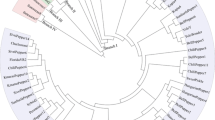Summary
Polymorphism in twelve genes coding for eight enzymes in pearl millet (Pennisetum glaucum (L.) R. Br.): alcohol dehydrogenases (ADH), catalases (CAT), β-esterases (EST), glutamate oxaloacetate transaminases (GOT), malate dehydrogenases (MDH), 6-Phosphogluconate dehydrogenases (PGD), phosphoglucoisomerases (PGI) and phosphoglucomutases (PGM), was observed by electrophoresis on 74 cultivated samples and 8 wild samples from West Africa. Six genes: Est A, Adh A, Pgm A, Cat A, Pgi A, Pgd A contain 95% of the total variation. Principal component analyses and discriminant analyses of the 82 samples described by 46 allelic frequencies showed an almost complete separation into 3 groups: wilds, early maturing cultivars and late maturing cultivars. The early group has the highest enzyme diversity, with cultivated millets from Niger showing the most diversity. The high diversity of the early group and its extensive divergence from West-African wild millets suggest, firstly, the existence, elsewhere in Africa of other enzymatically different sources of wild millet, and secondly, the occurrence, prehistorically, of several different domestications. The late group of cultivars has the lowest variability and a relatively low coefficient of differentiation. This relatively homogeneous enzyme structure does not seem to be associated to ecology. A hypothesis is advanced suggesting that West African late-cultivars were derived from a common cultivated early complex. This complex must have been distributed across the Sudanian zone and must have been later sumitted to modifications by limited gene flow with local early maturing cultivars.
Similar content being viewed by others
References
Banuett-Bourrillon F, Hague DR (1979) Genetic analysis of alcohol dehydrogenase isozymes in Pearl Millet (Pennisetum typhoïdes). Biochem Genet 20:369–383
Bono M (1973) Contribution à la morphosystématique des Pennisetum annuels cultivés pour leur grain en Afrique occidentale francophone. Agron Trop (Paris) 28:229–356
Brown AHD, Weir BS (1983) Measuring genetic variability in plant populations. In: Tanksley SD, Orton TJ (eds) Isozymes in plant genetics and breeding, part A. Elsevier, Amsterdam Oxford New York, pp 219–239
Brunken J, de Wet MJ, Harlan JR (1977) The morphology and domestication of Pearl Millet. Econ Bot 31:163–174
Cavalli-Sforza LL, Edwards AWF (1967) Phylogenetic analysis: models and estimation procedures. Am J Hum Gent 19:233–257
Clement JC (1985) Les mils pénicillaires de l'Afrique de l'Ouest — Prospections et collectes. IBPGR, Rome; ORSTOM, Abidjan, 231 pp
Gower JC (1966) Some distance properties of latent root and vector methods used in multivariate analysis. Biometrika 53:325–338
Harlan JR (1971) Agricultural origins: centers and non centers. Science 174:468–474
Leblanc JM, Pernès J (1983) Enzyme polymorphism of Pennisetum americanum in the Ivory Coast. Jpn J Genet 58:121–131
Marchais L (1982) La diversité phénotypique des mils pénicillaires cultivés au Sénégal et au Mali. Agron Trop (Paris) 37:68–80
Marchais L, Pernès J (1985) Genetic divergence between wild and cultivated Pearl Millets (Pennisetum typhoïdes). I. Male sterility. Z Planzenzücht 95:103–112
Nei M (1975) Molecular population genetics and evolution. North Holland, Amsterdam Oxford, 288 pp
Nei M, Roychoudhury AK (1973) Sampling variances of heterozygosity and genetic distance. Genetics 76:379–390
Portères R (1962) Berceaux agricoles primaires sur le continent africain. J Afr Hist 3:195–210
Sandmeier M, Béninga M, Pernès J (1983) Analyses des relations entre formes spontanée et cultivée chez le mil à chandelles. III. Etude de l'hérédité des estérases et des peroxydases anodiques. Agronomie 6:87–494
Second G (1982) Origin of the genic diversity of cultivated rice (Oryza spp.): study of the polymorphism scored at 40 isozyme loci. Jpn J Genet 57:25–57
Snedecor GW (1985) Statistical methods, 5th edn. Iowa State University Press, Ames, Iowa, p 534
Tostain S, Riandey MF (1984) Polymorphisme et déterminisme génétique des enzymes de mil (Pennisetum glaucum L.). Etude des alcool déshydrogénases, catalases, endopeptidases et estérases. Agron Trop (Paris) 39:335–345
Tostain S, Riandey MF (1985) Polymorphisme et déterminisme génétique des enzymes du mil pénicillaire (Pennisetum glaucum L.). Etude des malates déshydrogénases. Agronomie 5:227–235
Tostain S, Lavergne D (1986) Polymorphisme et déterminisme génétique des enzymes de mil (Pennisetum glaucum L.). Etude des glutamate oxaloacétate transaminases. CR Acad Sci, Ser III 302:181–184
Tostain S (1985) Mise en évidence d'une liaison génétique entre un gène de nanisme et des marqueurs enzymatiques chez le mil pénicillaire (Pennisetum glaucum L.). Can J Genet Cytol 27:751–758
Author information
Authors and Affiliations
Additional information
Communicated by G. S. Khush
Rights and permissions
About this article
Cite this article
Tostain, S., Riandey, M.F. & Marchais, L. Enzyme diversity in pearl millet (Pennisetum glaucum). Theoret. Appl. Genetics 74, 188–193 (1987). https://doi.org/10.1007/BF00289967
Received:
Accepted:
Issue Date:
DOI: https://doi.org/10.1007/BF00289967




